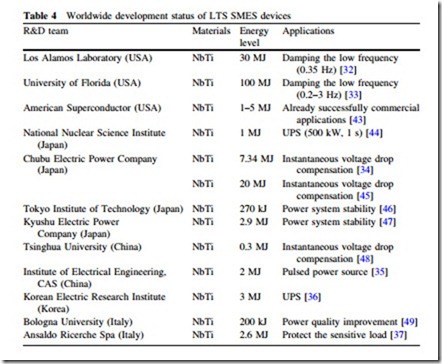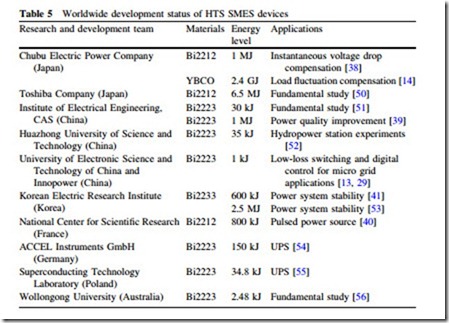Development Status of Worldwide SMES Devices
In recent years, with the development of superconducting materials, especially HTS materials with promising strong-current applications in large-scale magnets, various SMES devices have been fabricated and tested for practical power grids.
Serious interests in SMES began in the early 1960s as reliable low-temperature superconductors (LTSs) became available. The practical feasibility of the SMES concept has been demonstrated with the world’s first commercial 30 MJ NbTi SMES unit [32] used on the Pacific Intertie transmission line in the early 1980s. At this point in time, the LTS SMES technology is relatively mature and reliable; USA has developed several large-scale SMES devices, e.g., 30 MJ SMES in Los Alamos National Laboratory (LANL) [32], 100 MJ SMES in University of Florida [33], and has already achieved the primary process of commercialization. Other countries in the world have also developed several MJ-class LTS SMES devices, e.g., Chubu Electric Power Co. in Japan—7.34 MJ SMES [34], Chinese Academy of Sciences in China—2 MJ SMES [35], Korean Electric Research Institute in Korea—3 MJ SMES [36], Ansaldo Ricerche spa in Italy—2.6 MJ SMES [37], etc. The power system applications of the current LTS SMES devices include damping low-frequency oscillation in the interconnected grid, maintaining power system stability, compensating voltage dip, protecting critical load, etc. However, the high refrigeration loads, which is required to keep the LTS materials at 4.2 K, made the
LTS SMES uneconomical to practically operate. For LTS SMES further developments, the high refrigeration cost remains a significant barrier.
Immediately following the discovery of HTS materials in 1986, several studies looked into the feasibility of HTS SMES. Due to the anisotropy of 1G HTS tapes and immature HTS high-field magnet technology, the number of the worldwide HTS SMES devices is relatively few by comparison to LTS SMES devices, and the achieved capacities are limited to MJ-class, e.g., Chubu Electric Power Co. in Japan—1 MJ SMES [38], Chinese Academy of Sciences in China—1 MJ SMES [39], CNRS-CRTBT-LEG in France—0.8 MJ SMES [40], Korean Electric Research Institute in Korea—0.6 MJ SMES [41], etc. The HTS magnets in the above MJ-class HTS SMES devices are fabricated by 1G BSCCO tapes (Bi2212 or Bi2223), which have been considered as transitional materials for studying HTS magnet technology. With the continued development of HTS wires, the second generation (2G) YBCO tapes became more feasible, and their outstanding high- field properties make large-scale HTS SMES available, i.e., 2.4 GJ YBCO SMES [14]. Recently a new promising SMES technology based on MgB2 tapes has been proposed to combine with liquid hydrogen (LH2) for developing very compact hybrid ESSs, i.e., 48 GJ MgB2 LIQHYSMES [42].
The continuous progresses of HTS materials and SMES devices have formed the firm base for the SMES developments and applications ranging from small to large scales in distribution to transmission power systems and future SGs. In addition, the suitable reduction of capital cost for SMES devices with the price
reduction of HTS conductors (BSCCO tapes for about 35 $/kA·m or below, YBCO tapes for about 15 $/kA·m or below), large-scale SMES devices will become economically available, and will play an important role in future SGs.


